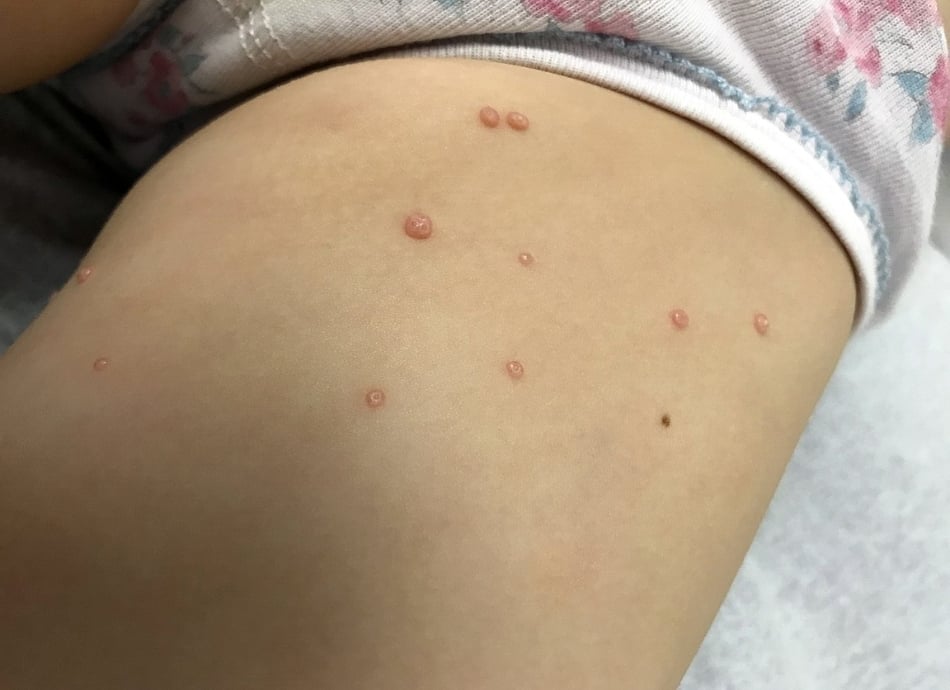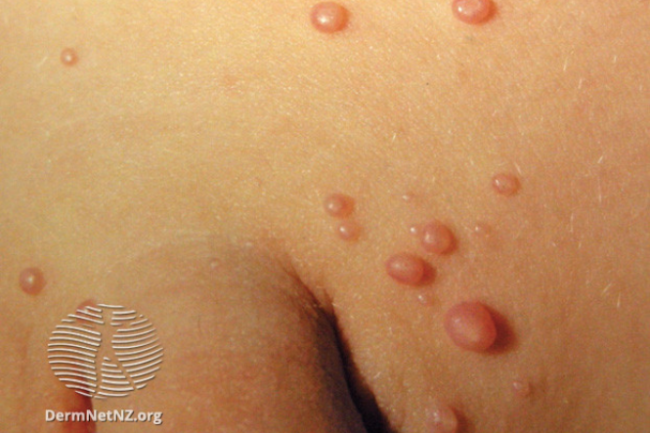Wishing everyone a safe and happy Christmas and New Year – Meri Kirihimete from the Healthify team.
Molluscum contagiosum viral skin infection
Key points about molluscum contagiosum
- Molluscum contagiosum is a common, mild skin infection caused by the molluscipoxvirus.
- It appears as small, waxy, raised lumps on the skin, each with a dent in the middle.
- Clusters can appear anywhere on your body such as your arms, legs, trunk, face, thighs, lower abdomen or genital area. They most commonly appear in warm moist places such as your armpit or groin.
- Molluscum contagiosum doesn’t usually require treatment and the lumps will eventually go away by themselves.
- It usually affects children, sexually active adults and people with a suppressed immune system.

Molluscum contagiosum is a common, mild skin infection. It looks like small, raised lumps on your skin. They are harmless and don’t cause pain. The shiny, waxy lumps range in size from 1 to 6 mm and have a dent in the middle.
Clusters of the lumps can appear anywhere on your body, including your arms, legs, trunk, face, thighs, lower abdomen or genital area. They also commonly appear in warm moist places such as your armpit.
Molluscum contagiosum is caused by a virus called molluscipoxvirus. It usually affects children, sexually active adults and people with a suppressed immune system. Because of their appearance the lumps can be confused with genital warts or pimples.
The lumps will eventually go away by themselves without treatment, as your body’s immune system starts to reject the virus.
The only symptom of molluscum contagiosum is small, raised lumps on the skin. These are usually painless but can sometimes be itchy, especially if they get inflamed.
- The lumps usually appear about 2 to 3 months after infection and can last for 6 months to 2 years.
- Most molluscum infections clear up within 1 year but some people find they get it again.
- Molluscum contagiosum is often associated with surrounding dermatitis (inflammation of the skin) where the affected skin becomes pink, dry and itchy.
- As the lumps begin to clear up, they usually become inflamed, crusted or scabby for a week or two. They may look infected, but this is part of the healing process.
People with a suppressed immune system may develop widespread and more persistent molluscum contagiosum and may need further treatment.

Image credit: DermNet NZ(external link)
Apps reviewed by Healthify
You may find it useful to look at the DermDiag app.
Molluscum contagiosum is spread by close skin-to-skin contact. Often the molluscum infection can spread further than the initial cluster through scratching and direct contact with other areas of the skin. It may spread between children swimming and bathing together or by sharing clothing or towels. Some people don't develop lumps even when they come into contact with the virus.
Can sexual partners also have molluscum contagiosum?
Yes, sometimes. It’s advisable for sexual partners to see a healthcare provider for a check-up if they have any unexplained lumps or itches.
Treatment isn’t usually required as your body’s immune system will start to reject the virus after several months and the lumps will resolve by themselves. Some people may seek treatment for cosmetic reasons when molluscum appears on their face or eyelids. In these cases, molluscum can be removed by your healthcare provider using a clean needle to remove the centre core, or by freezing or burning the lumps. This may leave a scar.
If you develop secondary dermatitis, it may be treated with a topical steroid cream. However, the dermatitis is unlikely to resolve until the molluscum infection has cleared up.
Although molluscum contagiosum isn’t a serious condition, there are a few potential complications that can occur. If the bumps are scratched or damaged, they can bleed and become infected resulting in redness, soreness and a yellow crust (impetigo). A temporary darkening in skin colour may occur after the spots have gone. Sometimes you may be left with spontaneous, pitted scarring, whether or not you’ve had any treatment.
If you develop redness, pain, widespread molluscum contagiosum or have any concerns, see your healthcare provider for a check.
In rare cases, the virus can spread to your eye and cause conjunctivitis or keratitis (a red eye).
Molluscum contagiosum appears long after you've been infected and is infectious while the lumps are present. However, affected children and adults should keep going to work, school and day care.
To reduce the spread:
- keep your hands clean
- avoid scratching and shaving
- cover all visible lumps with clothing or watertight plasters
- dispose of used plasters
- don't share towels, clothing or other personal effects
- adults should practice safe sex or abstinence.
Molluscum contagiosum(external link) DermNet NZ
Molluscum contagiosum in children(external link) KidsHealth, NZ
Molluscum factsheet(external link) Royal Children's Hospital Melbourne, Australia
Molluscum contagiosum(external link) NHS, UK
Apps
DermDiag app DermNet NZ
References
- Molluscum contagiosum(external link) Royal Children's Hospital Melbourne, Australia, 2020(external link)
- Molluscum contagiosum(external link) DermNet, NZ, 2021(external link)
- Molluscum contagiosum(external link) Healthline, US, 2022
Credits: Healthify editorial team. Healthify is brought to you by Health Navigator Charitable Trust.
Reviewed by: Professor Amanda Oakley CNZM, Dermatologist, Health New Zealand Waikato
Last reviewed:





